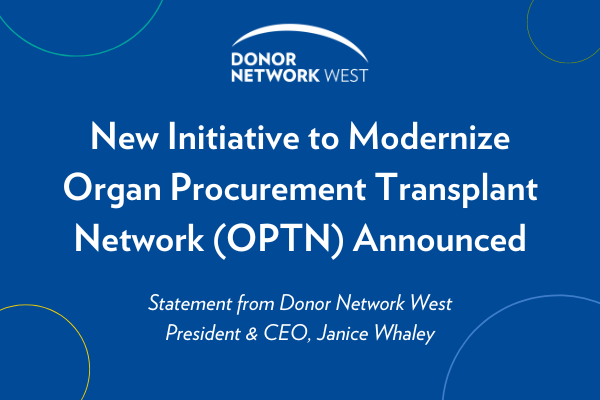HRSA Gets it Right in Prioritizing Patients Waiting for Organ Transplants by Bringing Transparency and Reform to the OPTN

By Janice F. Whaley, President and CEO of Donor Network West
March 23, 2023 – Donor Network West commends the Health Resources and Services Administration (HRSA) for its announcement to modernize the Organ Procurement and Transplantation Network (OPTN) through its just-announced OPTN Modernization Initiative. With a direct focus on the various complex processes that occur throughout donation and transplantation events, patients waiting for life-saving organ transplants will benefit from HRSA’s objective to strengthen accountability, equity, and performance in the organ donation and transplantation system.
Striving to obtain the best quality of service for patients, HRSA is asking for and has included in the President’s budget for fiscal year 2024, the OPTN Modernization Initiative, more than doubling HRSA’s budget for organ-related work to 67 million dollars. Donor Network West, along with its Bay Area transplant center partners, serve the largest number of patients waiting for transplants, from across northern California, northern Nevada, and from around the world. Patients and clinicians deserve the best resources to ensure the system operates at peak performance.
Donor Network West also applauds HRSA’s publication of organ donation outcomes by race, which significantly varies among organ procurement organizations (OPOs), and anticipates continued refinement of the data by CMS. Janice Whaley, Donor Network West’s President and CEO, along with members of the Organ Donation Consortium (ODC), recently met with the White House Office of Domestic Policy to discuss ways to increase organ donation in communities of color and recommended various actions intended to strengthen regulation of and assistance to OPOs in improving minority donation rates. They included increasing the transparency of donation rates by race and ethnicity throughout the country.
Under the Final Rule, CMS publishes OPO donation rates; by also publishing donation rates by race and ethnicity, opportunities for improvement can be identified. Among various race and ethnicity donation rates, a wide disparity exists. Lack of awareness surrounding this data prevents improvement efforts nationally among OPOs; hence the need to increase awareness of and sharpen focus on closing this gap. The public deserves to see how people of color are being served by the national organ donation system.
Whaley notes “Donor Network West, the OPO serving northern California and northern Nevada, has increased and sustained organ donation by 34% for the past four years. This was done by building bridges and focusing on meeting community and families where they are. Since 2018, the authorization rate has increased 83% for Black donors; by 32%, Asian, by 29% Hispanic and 22% White. For the first time in our organization, minority donors were greater than White donors in 2021 and 2022, a trend that will only continue based on northern California and Nevada’s changing racial and ethnic population. Donor Network West reflects its community: 52% of potential donors in 2021 were White, our staff- 50%; Asian 16% (15% staff), Hispanic 23% (18% staff) and Black 10% (9% staff). The community can see themselves in our life-saving work.”
‡ Lucile Salter Packard Children’s Hospital at Stanford
UCSF Medical Center at Mission Bay
University of California San Francisco Medical Center
California Pacific Medical Center-Van Ness Campus
Donor Network West saves and heals lives by facilitating organ and tissue recovery for transplantation and research. Established in 1987, Donor Network West is designated and certified by the Centers for Medicare and Medicaid Services, accredited by the American Association of Tissue Banks (AATB), is a member of the Organ Donation Alliance and is an official Donate Life organization. Donor Network West is federally designated to serve 45 counties in northern California and northern Nevada, Donor Network West partners with the Department of Motor Vehicles and the state-authorized donor registries to help increase donor registration. For information, visit www.DonorNetworkWest.org and follow us on social media: @mydnwest.
Support Donor Network West
